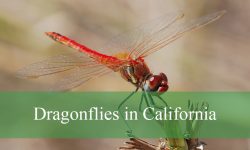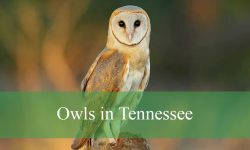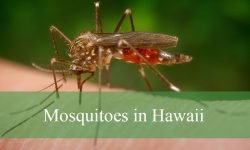Across North Carolina, countless species of beetles crawl, fly, and shine in nearly every type of habitat—from dense pine forests to backyard gardens. These fascinating insects appear in a dazzling range of colors and forms, from the metallic green of June beetles to the soft glow of summer fireflies. Each species adds something unique to the state’s rich natural diversity.
Beetles are among the most widespread and adaptable insects in North Carolina. While some can cause minor damage to plants or trees, most are beneficial creatures. They help control pests, decompose fallen wood, and pollinate wildflowers, quietly supporting the balance of local ecosystems.
In every corner of the state, from the mountains to the coast, beetles play an essential part in nature’s cycle. Let’s explore 15 of the most interesting and commonly found beetle species that make North Carolina their home.
Types of Beetles Found in North Carolina
Japanese Beetle (Popillia japonica)
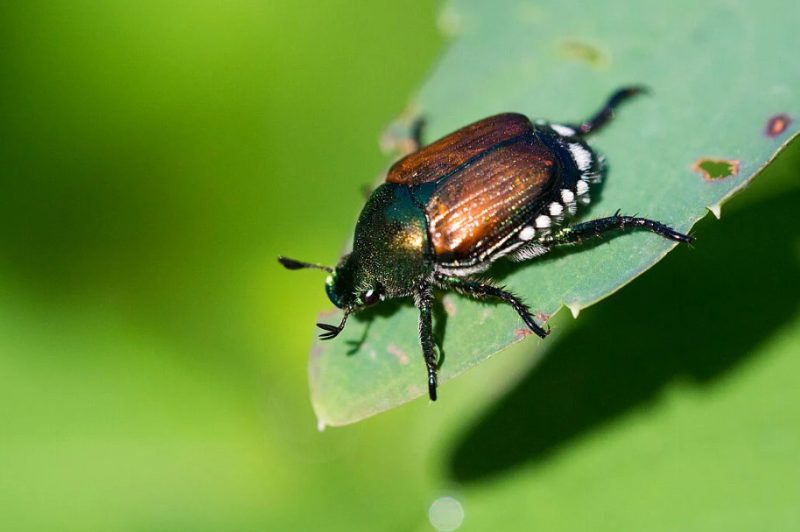
The Japanese Beetle is one of the most familiar and destructive beetles in North Carolina. It displays a brilliant metallic green head and thorax with shiny copper-brown wing covers, giving it a distinctive, reflective appearance under sunlight. Measuring around 0.5 inches in length, this beetle is small but easily recognizable thanks to its shimmering colors and the presence of five white hair tufts on each side of its abdomen.
In terms of behavior, the Japanese Beetle is a voracious feeder. It targets over 300 plant species, including roses, grapevines, fruit trees, and ornamental shrubs. When feeding, the adults consume the soft parts of leaves, leaving behind a delicate, lace-like pattern that can cause significant defoliation. Their feeding habits often occur in groups, intensifying the damage in gardens and agricultural areas.
These beetles are most active during warm, sunny days from late June through August. Adults typically emerge from the soil in early summer, mate, and lay eggs in grassy areas where the larvae—commonly called white grubs—develop. The grubs feed on grass roots, damaging lawns and turf while maturing underground during cooler months.
In North Carolina, Japanese Beetles are widespread across both urban and rural regions. They are especially common in the Piedmont and Coastal Plain areas, thriving in lawns, gardens, and agricultural fields. The species’ adaptability and lack of natural predators in North America have allowed it to spread rapidly since its introduction from Japan in the early 1900s.
Eastern Hercules Beetle (Dynastes tityus)
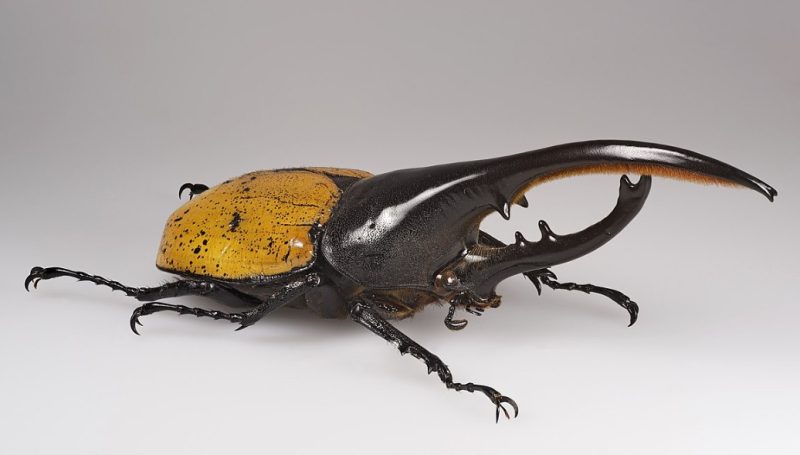
The Eastern Hercules Beetle is one of the largest and most impressive beetles found in North Carolina and the eastern United States. Males can reach lengths of up to 2.5 inches, including their long, horn-like projections extending from both the head and thorax. Females lack these horns but are still large and robust. Their bodies are typically grayish-green with black spots, though coloration can vary depending on humidity and environment.
Despite their imposing appearance, these beetles are harmless and non-aggressive. The males use their massive horns to battle rivals for access to females during the mating season. These contests are more about pushing and grappling than causing injury, showcasing fascinating beetle strength. Both males and females are strong fliers, though they are often found resting on tree trunks or near decaying logs during the day.
The Eastern Hercules Beetle primarily inhabits hardwood forests, particularly areas with abundant rotting wood where their larvae can thrive. The larvae, which can grow to several inches long, develop inside decomposing wood, feeding on decayed organic matter for over a year before emerging as adults. This long development period makes them important decomposers in the forest ecosystem.
In North Carolina, they are most commonly encountered in forested regions across the Piedmont and Mountain areas. They are nocturnal and are frequently drawn to lights on warm summer nights. Although they look intimidating, these gentle giants play a crucial role in nutrient recycling and maintaining healthy woodland habitats.
Green June Beetle (Cotinis nitida)
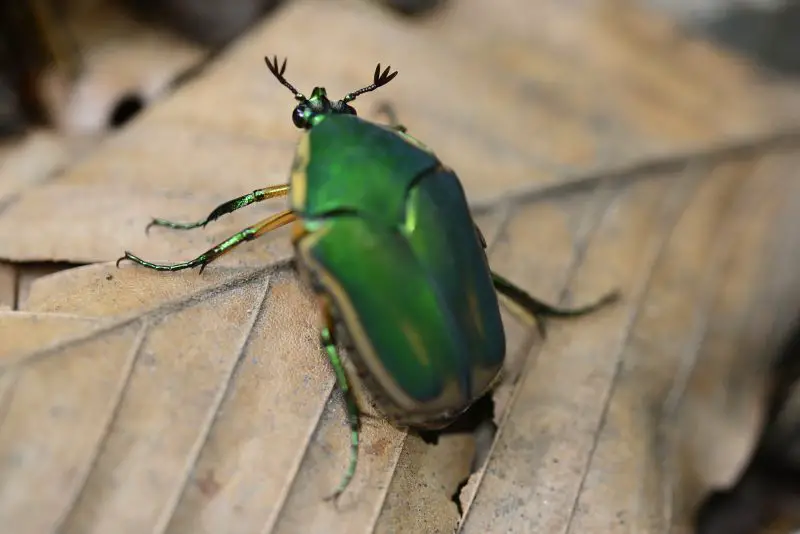
The Green June Beetle is a large, metallic green beetle often seen buzzing loudly over lawns and gardens during the summer months in North Carolina. Adults measure about 1 inch in length, with shiny green upper surfaces and bronze or golden undersides. Their coloring makes them stand out as they fly clumsily through the air, often startling those unfamiliar with their harmless nature.
Behaviorally, these beetles are active during the day, especially in bright sunlight. They are attracted to ripe or fermenting fruits such as peaches, grapes, apples, and berries. Occasionally, they will also feed on sap flows from trees or sweet-smelling plant materials. Their buzzing flight and sudden landings make them easy to identify as they search for food sources in gardens or orchards.
The larvae of the Green June Beetle, known as white grubs, develop in the soil beneath lawns and pastures. They feed on decaying organic material and sometimes on plant roots, which can lead to turf damage. Interestingly, these grubs are capable of moving on their backs, propelling themselves across the ground when exposed.
In North Carolina, Green June Beetles are widespread throughout the state, particularly in agricultural and suburban areas. They are most abundant during the summer, from late June through August. Although their feeding can cause moderate damage to fruit crops, they play a valuable role in breaking down organic matter and enriching the soil.
Carolina Tiger Beetle (Tetracha carolina)
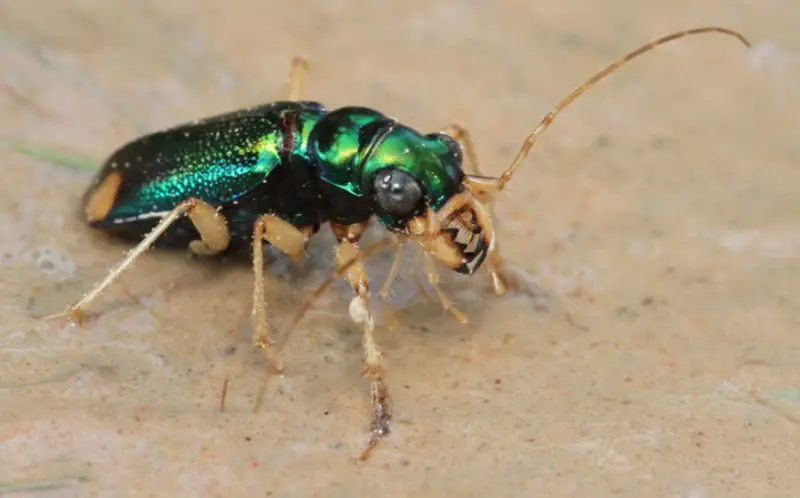
The Carolina Tiger Beetle is a striking and fast-moving predator found throughout North Carolina. It features a metallic green or bronze body that shimmers under the sun, with long, slender legs adapted for rapid running. Measuring around 1 inch in length, this beetle has large mandibles and prominent eyes that give it an alert, aggressive look typical of tiger beetles.
This species is known for its speed and hunting prowess. The Carolina Tiger Beetle preys on smaller insects, using its sharp mandibles to grasp and consume them quickly. During the day, it is often seen darting across sandy paths, open fields, and forest edges in pursuit of prey. When disturbed, it can fly short distances before landing and resuming its hunt, making it difficult to catch.
Adults are most active during warm months, from spring through late summer. They prefer open, sunlit environments with sandy or bare soils where they can easily run and hunt. The larvae live in vertical burrows in the ground, ambushing unsuspecting prey that wanders too close. This combination of agility and patience makes them one of nature’s most efficient insect predators.
In North Carolina, the Carolina Tiger Beetle is commonly found in the Coastal Plain and Piedmont regions. They thrive in areas like sandy trails, riverbanks, and dry fields. Their presence is often a sign of a healthy insect ecosystem, as they help regulate populations of other small arthropods.
Red Milkweed Beetle (Tetraopes tetrophthalmus)
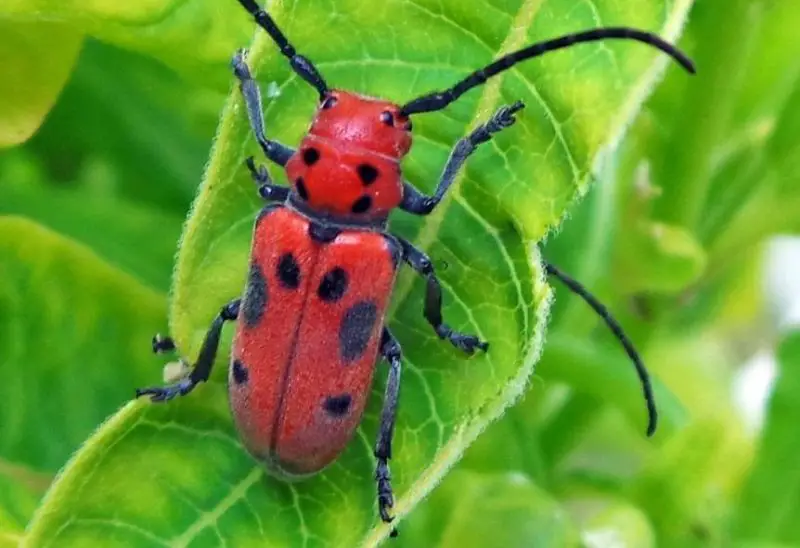
The Red Milkweed Beetle is one of the most visually striking beetles found in North Carolina’s meadows and fields. It has a vivid red-orange body with black spots on its wing covers, and its long black antennae curve gracefully over its head, intersecting its eyes—a feature that inspired its scientific name, meaning “four-eyed.” Adults typically measure around 0.4 to 0.6 inches long and are easy to spot on milkweed plants.
This beetle’s behavior is closely tied to milkweed, its primary host plant. Both adults and larvae feed on different parts of the plant, from leaves and stems to roots. By consuming milkweed, they accumulate toxic compounds called cardenolides, which make them distasteful or poisonous to predators such as birds. Their bright red coloration serves as a warning signal in nature, advertising their toxicity.
The Red Milkweed Beetle is most active during the summer months when milkweed is abundant. Adults can often be seen basking on plant stems in full sunlight or mating and laying eggs at the base of milkweed plants. The larvae develop underground, feeding on milkweed roots before emerging as adults the following year.
In North Carolina, this species is widespread in open grasslands, prairies, and roadsides where milkweed naturally grows. They are particularly common in the Piedmont and Coastal Plain regions. Their dependence on milkweed also links them ecologically with monarch butterflies, making both species important indicators of healthy native plant habitats.
Firefly (Photinus pyralis)
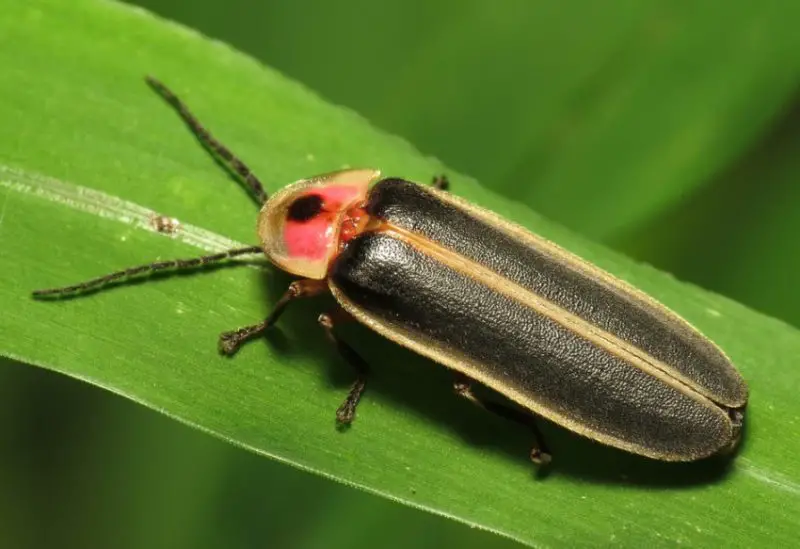
The Firefly, also known as the Common Lightning Bug, is one of North Carolina’s most enchanting insects. This beetle is easily recognized by its soft, elongated body, which measures about 0.5 inches in length. Its wing covers are typically black or dark brown, and the abdomen ends with a light-producing organ that glows yellow-green at night. This bioluminescent feature is what gives the firefly its magical appearance on summer evenings.
Fireflies are best known for their unique flashing patterns, which they use for communication and mating. Each species of firefly has its distinct rhythm of light pulses that males and females use to recognize one another. Males often fly through the air flashing their light, while females remain perched in vegetation, responding to the correct sequence. These light displays usually occur during warm, humid summer nights, especially near water sources like ponds or marshes.
Behaviorally, fireflies are gentle and mostly nocturnal. Adults feed on nectar, pollen, or may not eat at all, while the larvae are active predators that feed on snails, slugs, and worms in moist soil. The larvae, often called “glowworms,” can also produce light, which serves as a deterrent to potential predators.
In North Carolina, the Firefly is common throughout the state, particularly in the Piedmont and Coastal Plain regions. They thrive in areas with high humidity and minimal light pollution, such as forest edges, grassy meadows, and suburban gardens. Their presence not only adds beauty to summer nights but also indicates a healthy, balanced ecosystem.
Banded Net-wing Beetle (Calopteron discrepans)
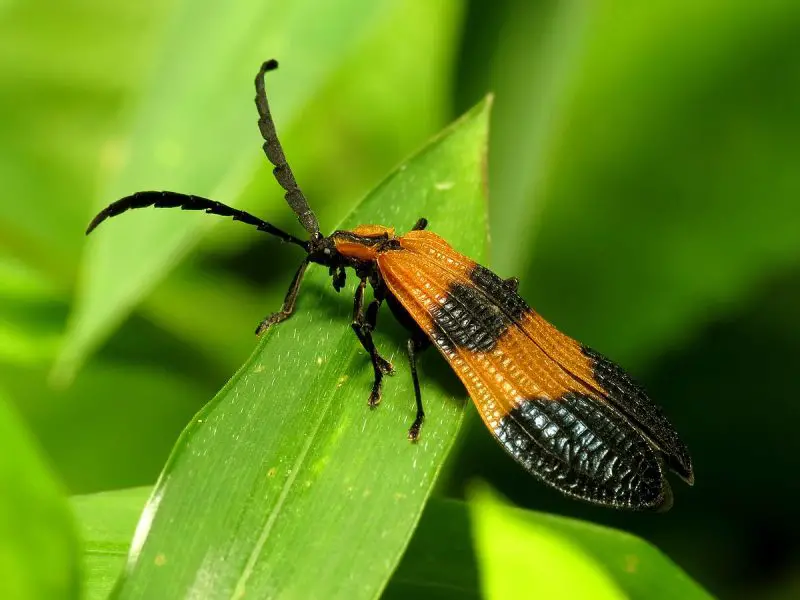
The Banded Net-wing Beetle is one of the most visually distinctive beetles found in North Carolina’s forests. It has a soft, flattened body with bright orange wings marked by bold black bands near the tips. Measuring around 0.6 inches in length, this beetle mimics the appearance of toxic species, using its vivid colors as a warning to predators. Its delicate, net-like wing texture gives the insect its common name.
In terms of behavior, adult Banded Net-wing Beetles are diurnal and can often be seen perched on foliage or flowers in wooded areas. They are slow-moving insects that rely on their aposematic (warning) coloration for protection rather than speed or flight. Their flight is somewhat clumsy, and they are rarely seen far from vegetation or shaded forest environments.
Larvae of this species develop under the bark of decaying logs, where they feed on decomposing plant matter and fungi. This makes them an important part of the forest’s nutrient recycling process. The larvae overwinter in this habitat, later pupating and emerging as adults during the warmer months.
In North Carolina, the Banded Net-wing Beetle is most common in deciduous forests, especially during late spring and summer. They are often found in the Piedmont and Mountain regions, where mature forests provide ample decaying wood. Their harmless nature and ecological role make them a valuable species in maintaining healthy woodland ecosystems.
Click Beetle (Alaus oculatus)
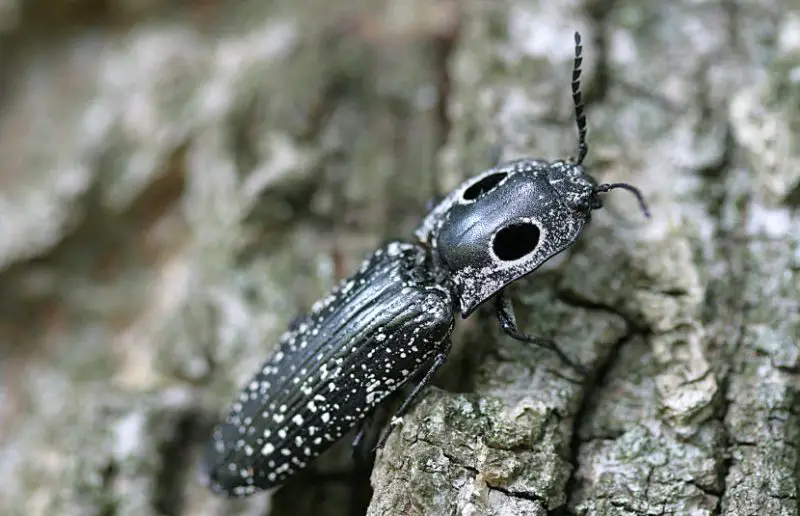
The Click Beetle, scientifically known as Alaus oculatus, is one of the most remarkable beetles in North Carolina due to its striking appearance. It has a long, black body with fine white speckles and two large, eye-like spots on its pronotum that resemble owl eyes. These false eyes serve to intimidate potential predators. Adults typically range between 1 to 1.75 inches in length, making them one of the larger members of the click beetle family.
This beetle’s most famous behavior is its ability to “click” and flip into the air when it finds itself on its back. It does this by snapping a spine in its thorax against a notch, creating a sharp clicking sound and propelling itself several inches into the air. This sudden motion can startle predators and help the beetle right itself. Despite their intimidating look, Click Beetles are harmless to humans.
The larvae, known as wireworms, live inside decaying wood or soil, where they feed on organic matter and small insects. They can remain in this stage for several years before maturing into adults. Adults are mostly nocturnal and are often attracted to lights at night during the spring and summer months.
In North Carolina, Click Beetles are common in wooded and rural areas, especially in regions with plenty of fallen logs or rotting stumps. They are found across the state, from the Coastal Plain to the Mountain region. Their unique defense mechanism and striking pattern make them one of the most fascinating beetles to observe in the wild.
Soldier Beetle (Chauliognathus pensylvanicus)
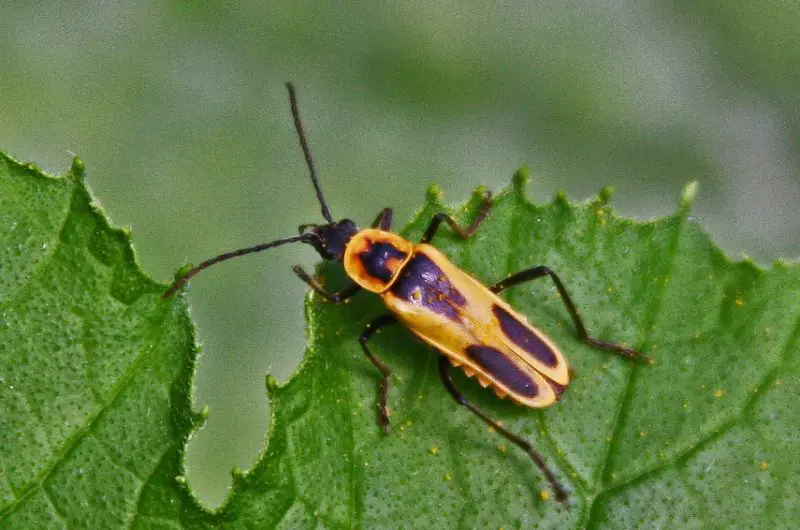
The Soldier Beetle, also called the Goldenrod Soldier Beetle, is a familiar sight in North Carolina during late summer. This slender beetle has a soft, flexible body that measures around 0.5 inches long. Its yellow-orange coloration with black markings on the wings and head gives it a distinctive appearance, somewhat resembling a wasp—though it is entirely harmless.
Soldier Beetles are often seen on flowers, particularly goldenrods, where they feed on nectar and pollen. They are beneficial insects because, in addition to pollination, they also prey on small pests such as aphids and caterpillars. Their flight is steady and controlled, and they are active during warm, sunny days.
Larvae live in soil and leaf litter, where they act as predators, feeding on soft-bodied insects and insect eggs. This dual role—pollination as adults and pest control as larvae—makes Soldier Beetles highly valuable in natural and agricultural ecosystems. They overwinter as larvae and emerge as adults in late summer.
In North Carolina, the Goldenrod Soldier Beetle is widely distributed and especially abundant in meadows, fields, and roadside areas where wildflowers bloom. Their presence often peaks in August and September. These beetles contribute significantly to garden health, both as pollinators and natural pest regulators.
Ground Beetle (Carabus nemoralis and others)
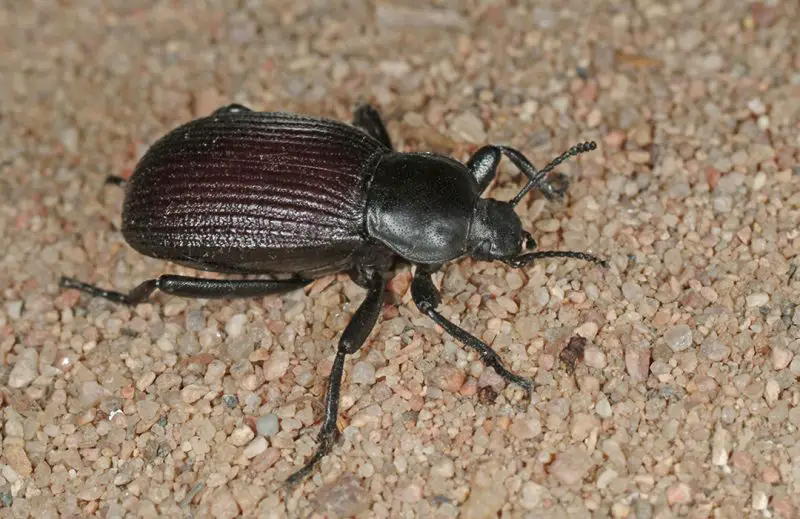
Ground Beetles represent a diverse group of nocturnal predators that are highly beneficial to North Carolina’s ecosystems. Most species, including Carabus nemoralis, have shiny, dark-colored bodies—often black, bronze, or metallic blue—and measure between 0.5 and 1 inch long. Their long legs and streamlined bodies are perfectly adapted for running quickly over the ground in pursuit of prey.
Ground Beetles are primarily nocturnal hunters. They feed on a wide range of invertebrates, including caterpillars, slugs, ants, and other soft-bodied insects. Many species are flightless and spend their lives scurrying beneath rocks, logs, and leaf litter. Their powerful jaws allow them to subdue even larger prey, making them an important natural form of pest control.
The larvae are just as predatory as adults, living underground and preying on soil-dwelling insects. Both stages help reduce pest populations, especially in agricultural areas. Some species can live for several years, surviving winters by burrowing into the soil or hiding under debris.
In North Carolina, Ground Beetles are found statewide across various habitats—from forests and grasslands to gardens and agricultural fields. They are especially active during warm, humid nights. Their abundance and ecological role as natural pest suppressors make them essential allies for farmers and gardeners alike.
Pine Sawyer Beetle (Monochamus scutellatus)
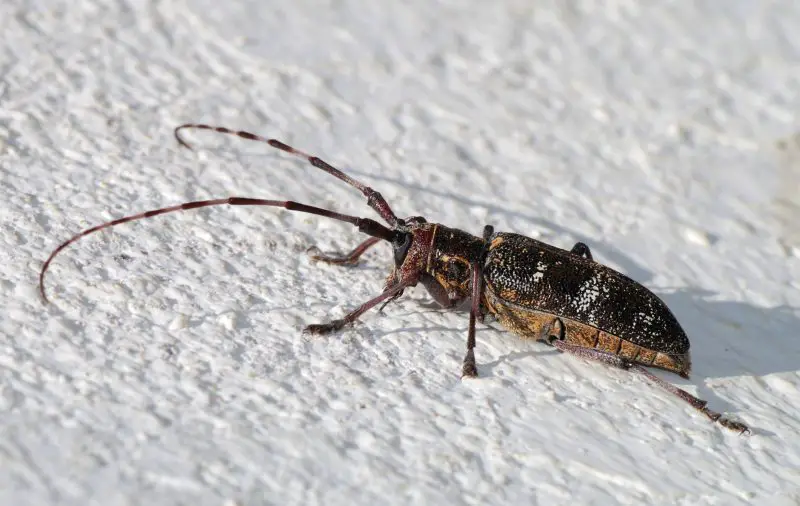
The Pine Sawyer Beetle is a large longhorn beetle commonly found in North Carolina’s pine forests. Adults are grayish-black with irregular white patches and very long antennae—often longer than their own bodies. These beetles can reach lengths of up to 1 inch, with males typically having longer antennae than females. Their body texture is rough and covered with fine hairs, helping them blend into tree bark.
These beetles are often mistaken for the invasive Asian Longhorned Beetle, but Pine Sawyers are native and beneficial in forest ecosystems. Adult beetles emerge from dead or dying pine trees, where they feed on bark and needles before mating. The males produce a high-pitched squeaking sound by rubbing body parts together—a behavior known as stridulation—to attract females.
The larvae of the Pine Sawyer Beetle, commonly called roundheaded borers, play a key role in forest decomposition. They tunnel deep into pine wood, feeding on the inner bark and sapwood of weakened or fallen trees. This helps accelerate the breakdown of dead timber, returning nutrients to the soil. However, they can occasionally infest recently cut logs or timber if left unattended.
In North Carolina, the Pine Sawyer Beetle is found throughout the state, especially in the Mountain and Piedmont regions where pine trees are abundant. They are most active in late spring and summer, often seen on pine trunks or near logging sites. Their presence indicates a healthy forest cycle of decay and renewal.
Lady Beetle (Coccinella septempunctata and others)
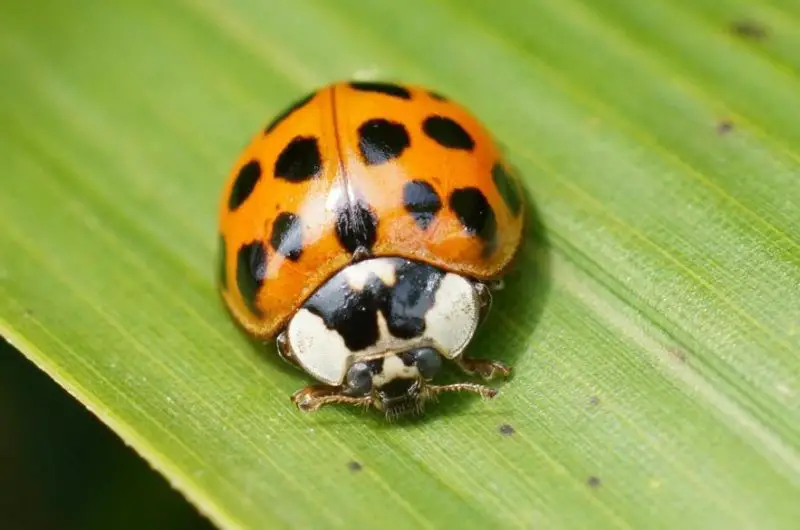
Lady Beetles, more affectionately known as ladybugs, are some of the most recognized and beloved beetles in North Carolina. These small, dome-shaped insects are typically bright red or orange with distinct black spots, although color and pattern variations exist among species. The most familiar species, the Seven-Spotted Lady Beetle (Coccinella septempunctata), has seven black dots arranged on its wing covers and measures about 0.3 inches in length.
Lady Beetles are well-known for their beneficial behavior in gardens and farms. Both adults and larvae feed voraciously on soft-bodied pests such as aphids, mealybugs, and scale insects. This makes them one of nature’s most effective natural pest controllers. Gardeners often rely on their presence to reduce pesticide use and maintain ecological balance.
The lifecycle of a lady beetle includes four stages—egg, larva, pupa, and adult. The larvae are elongated, black, and spiny, often resembling tiny alligators. They are equally predatory and consume hundreds of aphids during development. Adults can live several months, overwintering under bark, leaves, or inside buildings.
In North Carolina, several species of lady beetles thrive across urban, agricultural, and forested landscapes. They are most abundant from spring through late fall. Introduced species like the Multicolored Asian Lady Beetle coexist with native ones, though sometimes competitively. Regardless of species, their ecological importance as pest regulators is immense.
Blister Beetle (Epicauta pensylvanica)
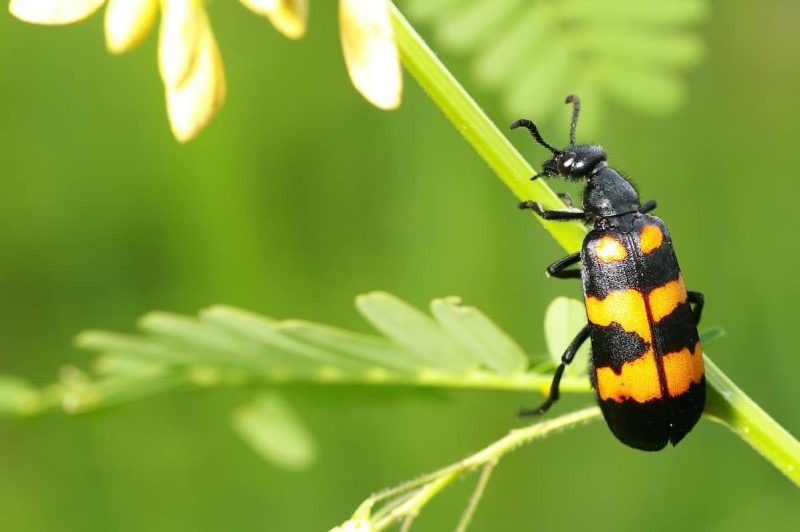
The Blister Beetle is a slender, soft-bodied insect that stands out for its chemical defenses and unique life cycle. Adults are typically gray or black, measuring between 0.5 and 1 inch long, with elongated bodies and flexible wing covers. Their simple coloration conceals a potent chemical weapon: cantharidin, a toxic compound capable of causing blisters upon contact with human skin.
Blister Beetles are both fascinating and potentially harmful. When disturbed or crushed, they release cantharidin as a defense mechanism against predators. This compound can irritate human skin and is dangerous if ingested by livestock, particularly horses consuming contaminated hay. Despite this risk, the beetles themselves do not bite or sting.
Their larvae, however, play an important ecological role. They develop as parasitoids of grasshopper eggs, feeding on them and helping regulate grasshopper populations naturally. Adults feed on flowers, especially those in the legume and aster families, and can sometimes be seen clustering on blossoms in late summer.
In North Carolina, Blister Beetles are widespread across rural and agricultural areas. They are most active from late spring to early autumn. Though often regarded as pests because of their toxic nature, their role in natural pest control makes them a complex but vital part of the ecosystem.
Reddish-Brown Stag Beetle (Lucanus capreolus)
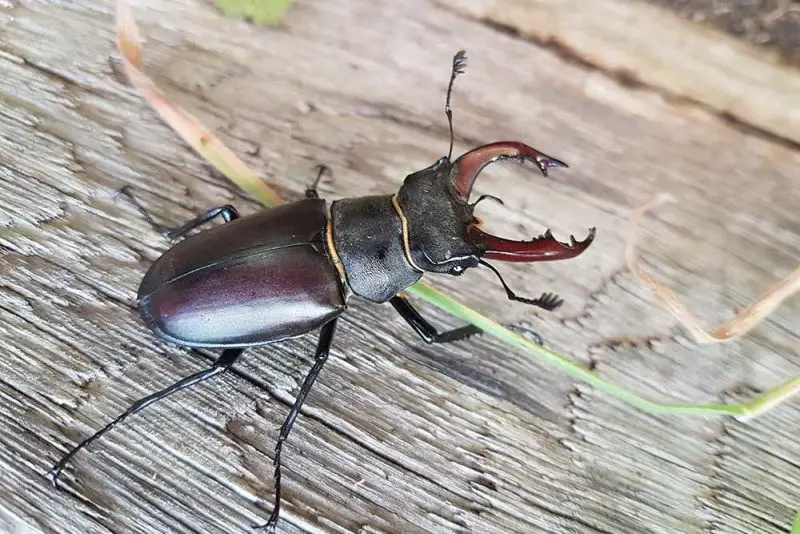
The Reddish-Brown Stag Beetle is one of North Carolina’s most striking beetles, admired for its large mandibles and glossy reddish-brown coloration. Adult males can reach lengths of up to 1.3 inches, with their long, antler-like jaws used for wrestling rivals during mating season. Females are smaller and lack the exaggerated mandibles but share the same smooth, shiny exoskeleton.
These beetles are primarily nocturnal and are often attracted to outdoor lights on warm summer nights. Males can sometimes be seen clinging to tree trunks, particularly oaks, feeding on tree sap or juices from decaying fruit. Despite their fierce appearance, stag beetles are entirely harmless to humans and are slow, deliberate movers when handled.
Larvae develop inside rotting wood, where they feed on decomposing material for one to two years before pupating. This long developmental period allows them to play a critical role in forest decomposition, breaking down wood and recycling nutrients back into the soil. Adult beetles typically live only a few months after emerging.
In North Carolina, the Reddish-Brown Stag Beetle is found in wooded regions throughout the Piedmont and Mountain areas. They are most commonly observed during summer evenings, especially near old trees or forested yards. Their presence is a positive indicator of healthy woodland ecosystems rich in decaying timber.
Dung Beetle (Onthophagus hecate)
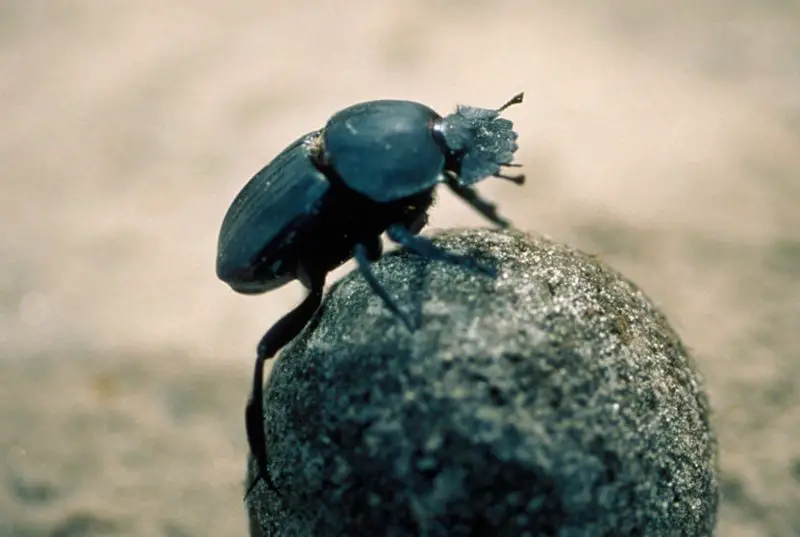
The Dung Beetle, particularly Onthophagus hecate, is a small but ecologically powerful insect found across North Carolina. Adults are usually black or dark bronze, measuring around 0.4 inches in length, with a robust, rounded body built for digging. Some individuals display small horns on the head, especially males, which they use for competition during mating.
Dung Beetles are famous for their unique feeding and nesting behavior. They collect animal droppings, roll them into small balls, and bury them underground for consumption or as a food source for their larvae. This process improves soil structure and fertility by recycling organic matter and returning nutrients to the earth.
Their ecological contributions extend beyond nutrient recycling. By burying dung, they help control parasites and flies, reducing disease risks for wildlife and livestock. Their tunneling also aerates the soil, enhancing water absorption and promoting plant growth.
In North Carolina, Onthophagus hecate and other dung beetle species are common in pastures, farmlands, and forest edges where mammals are present. They are active from spring through late fall, especially in warmer months. Despite their small size, dung beetles play a vital role in maintaining ecological balance and soil health throughout the state.
FAQs About Beetles in North Carolina
Are beetles harmful in North Carolina?
Most beetles in North Carolina are not harmful to humans. While a few species, such as the Blister Beetle, can cause mild irritation due to the chemical cantharidin, the vast majority are harmless. Some beetles can become nuisances indoors—like carpet beetles or powderpost beetles that infest wood or fabrics—but they rarely pose a serious health threat. Many beetles, including lady beetles, ground beetles, and dung beetles, are actually beneficial because they help control pests and recycle nutrients in nature.
What time of year are beetles most active in North Carolina?
Beetle activity in North Carolina typically peaks from late spring through early fall, especially during warm and humid months. Species like the Japanese Beetle and Green June Beetle are most active in midsummer, while others, such as Fireflies, are abundant during warm, humid evenings from June to August. Beetle larvae, which live in soil or decaying wood, remain active year-round but develop more slowly during the cooler winter months.
Which beetles are beneficial to the environment?
Many beetles in North Carolina play essential ecological roles. Lady Beetles control aphids and garden pests, Ground Beetles hunt soil-dwelling insects, and Dung Beetles recycle animal waste and improve soil fertility. Pine Sawyer Beetles and Stag Beetles assist in breaking down decaying wood, helping forests regenerate naturally. These beneficial species contribute to pest control, nutrient cycling, and overall ecosystem health.
Are there any invasive beetles in North Carolina?
Yes, a few invasive beetles have made their way into North Carolina. The most notable is the Japanese Beetle (Popillia japonica), introduced from Japan in the early 1900s. It causes widespread damage to ornamental plants and fruit crops. Other invasive beetles, such as the Emerald Ash Borer (Agrilus planipennis), have also been detected and are a serious concern for native ash trees. State agencies monitor and manage these populations to protect North Carolina’s forests and landscapes.
What should I do if beetles get inside my home?
If beetles enter your home, it’s important first to identify the species. Many are simply accidental visitors attracted to lights or shelter. Removing them with a vacuum or gently releasing them outdoors is often enough. For beetles that infest stored food, fabrics, or wood, cleaning and sealing entry points can help. Reducing outdoor lighting and keeping windows closed at night can also limit their attraction. Pesticides are rarely necessary unless infestations are severe and should always be used carefully.
Why do fireflies glow in North Carolina summers?
Fireflies, especially Photinus pyralis, glow to attract mates. The flashing light is produced through a chemical reaction in their abdomen involving luciferin and oxygen. Each species has its own flash pattern, which helps males and females recognize each other. North Carolina’s warm, humid summer evenings provide perfect conditions for this display, making firefly watching a favorite pastime across the state.
What beetles are commonly seen around gardens and homes?
Common beetles around North Carolina gardens include the Lady Beetle, Japanese Beetle, Green June Beetle, and Soldier Beetle. While some, like Japanese Beetles, feed on plants and flowers, others such as Lady Beetles and Soldier Beetles are natural pest controllers. Ground Beetles may also be found in gardens, where they hide under rocks and mulch by day and hunt pests at night.
Are beetles important for North Carolina’s ecosystems?
Absolutely. Beetles are one of the most important and diverse groups of insects in North Carolina’s ecosystems. They contribute to pollination, decomposition, pest control, and nutrient cycling. Forest beetles like Pine Sawyers and Stag Beetles break down decaying wood, while Dung Beetles enrich the soil. Their presence reflects the health of local habitats, and conserving natural beetle populations supports biodiversity statewide.
Can beetles damage trees or crops?
Some beetles can cause damage to trees and crops, particularly those that feed on living plant tissue. The Japanese Beetle and Green June Beetle are known for skeletonizing leaves and damaging fruit trees. Pine Sawyer Beetles may infest weakened pine trees, but they primarily target already dead or dying wood. In most cases, beetle infestations can be managed through natural predators, proper lawn care, and avoiding excessive pesticide use that harms beneficial insects.
How can I attract beneficial beetles to my yard?
To attract beneficial beetles, create a welcoming environment that includes native plants, mulch, and minimal pesticide use. Flowering plants like goldenrods, daisies, and milkweed attract Soldier Beetles and Lady Beetles. Maintaining compost or leaf litter helps Ground Beetles and Dung Beetles thrive. Providing a mix of sunny spots and shaded areas, along with moisture-rich soil, can make your garden a haven for these helpful insects.

